Evidence for Biogenic Silica Occurrence in the Lower Silurian Longmaxi Shale in Southeastern Chongqing, China
Abstract
1. Introduction
2. Geological Setting and Sampling
3. Analytical Methods
3.1. TOC
3.2. Mineralogical Composition
- Whole rock XRD analysis.
- The samples were crushed to a powder with a particle size less than 40 μm, and the samples were measured in an angular range of 5–70° 2θ to obtain the XRD patterns. The total clay mineral content and non-clay mineral content were determined using quantitative analysis.
- Clay mineral XRD analysis.
- First, the samples were ground to a particle size of less than 1 mm, and powdered samples were dispersed ultrasonically in distilled water. A suspension with a particle size of less than 2 μm was extracted and was centrifugally separated to cause the clay particles to settle. After drying, the clay samples were made into oriented slices, which were analyzed in an angular range of 3–30° 2θ to obtain the XRD patterns. Quantitative analysis was used to obtain the relative contents of different clay minerals.
3.3. Major Elements
3.4. SEM and EDS
4. Results
4.1. Organic Matter Characteristics
4.2. Mineral Composition
4.3. Major Elements
5. Discussion
5.1. Crystal Morphology of Silica
5.2. Origin of Silica
5.2.1. Assessment of Detrital Input
5.2.2. Assessment of Clay Mineral Transformation
0.02 CaO)] → [(Al4.12Fe0.1Mg0.56)(Si7.17)O20(OH)4(K1.47Na0.01Ca0.03)] (illite, 787.2 g) +
3.29 SiO2 (197.7 g) + 0.56 Na2O + 0.55 MgO + 3.23 H2O
5.2.3. Assessment of Hydrothermal Alteration
5.2.4. Biogenic Origin of Silica
5.3. Relationship between Mineral and TOC
5.4. The Link between Ancient Organism and Biogenic Silica
5.5. Diagenetic Transformation Mechanism of Biogenic Silica
6. Conclusions
- Numerous cryptocrystalline silicas with poorly crystalline morphology, which differed from that of detrital silica, authigenic silica, and hydrothermal silica, proved that there may be biogenic silicas occurrence in the Longmaxi shale.
- The lack of correlation between K2O/Al2O3 and SiO2/Al2O3 and a negative correlation between TiO2 and SiO2/Al2O3 excludes a terrigenous detrital origin of the silicas. Moreover, the lack of correlation between illite and SiO2, and negative correlations between illite and quartz and excess Si and between Al2O3 and excess Si proved that the silicas were not derived from clay mineral transformation. In addition, the fact that all samples were located in the non-hydrothermal origin area in the Al-Fe-Mn diagram excludes a hydrothermal origin of the silicas.
- Almost all samples plotted above the illite Si/Al line in the cross-plot of Si versus Al, suggesting the existence of biogenic silica. Furthermore, the mean values of Al/(Al + Fe + Mn) and Si/(Si + Al + Fe + Ca) were 0.68 and 0.70, respectively, which were close to the values of biogenic silica. These pieces of evidence prove that the silicas are primarily of biogenic origin.
- There was a considerable amount of ancient organism microfossils in the Longmaxi shales and positive correlations between TOC and quartz and excess Si, indicating that silicas are associated with siliceous organisms.
- The postmortem siliceous organisms of the Early Silurian in the southeastern Chongqing area underwent a diagenetic process of opal-A → opal-CT → cryptocrystalline biogenic silica after burial. This sequence proceeded via a dissolution-precipitation mechanism as the burial depth and temperature increased.
Author Contributions
Funding
Acknowledgments
Conflicts of Interest
References
- Rong, J.; Wang, Y.; Zhan, R.; Fan, J.; Huang, B.; Tang, P.; Li, Y.; Zhang, X.; Wu, R.; Wang, G.; et al. Silurian integrative stratigraphy and timescale of China. Sci. China Earth Sci. 2019, 62, 89–111. [Google Scholar] [CrossRef]
- Lüning, S.; Craig, J.; Loydell, D.K.; Štorch, P.; Fitches, B. Lower Silurian ‘hot shales’ in North Africa and Arabia: Regional distribution and depositional model. Earth Sci. Rev. 2000, 49, 121–200. [Google Scholar] [CrossRef]
- Fan, J.; Melchin, M.J.; Chen, X.; Wang, Y.; Zhang, Y.; Chen, Q.; Chi, Z.; Chen, F. Biostratigraphy and geography of the Ordovician-Silurian Lungmachi black shales in South China. Sci. China Earth Sci. 2011, 54, 1854–1863. [Google Scholar] [CrossRef]
- Dong, D.; Wang, Y.; Li, X.; Zou, C.; Guan, Q.; Zhang, C.; Huang, J.; Wang, S.; Wang, H.; Liu, H.; et al. Breakthrough and prospect of shale gas exploration and development in China. Nat. Gas Ind. 2016, 36, 19–32. (In Chinese) [Google Scholar] [CrossRef]
- Ma, Y.; Cai, X.; Zhao, P. China’s shale gas exploration and development: Understanding and practice. Pet. Explor. Dev. 2018, 45, 589–603. [Google Scholar] [CrossRef]
- Dong, D.; Gao, S.; Huang, J.; Guan, Q.; Wang, S.; Wang, Y. A discussion on the shale gas exploration & development prospect in the Sichuan Basin. Nat. Gas Ind. 2014, 34, 1–15. (In Chinese) [Google Scholar]
- Jin, Z.; Hu, Z.; Gao, B.; Zhao, J. Controlling factors on the enrichment and high productivity of shale gas in the Wufeng-Longmaxi Formations, southeastern Sichuan Basin. Earth Sci. Front. 2016, 23, 1–10. (In Chinese) [Google Scholar]
- Sugisaki, R.; Yamamoto, K.; Adachi, M. Triassic bedded cherts in central Japan are not pelagic. Nature 1982, 298, 644–647. [Google Scholar] [CrossRef]
- Yamamoto, K. Geochemical characteristics and depositional environments of cherts and associated rocks in the Franciscan and Shimanto Terrenes. Sediment. Geol. 1987, 52, 65–108. [Google Scholar] [CrossRef]
- Milliken, K.L.; Ergene, S.M.; Ozkan, A. Quartz types, authigenic and detrital, in the Upper Cretaceous Eagle Ford Formation, South Texas, USA. Sediment. Geol. 2016, 339, 273–288. [Google Scholar] [CrossRef]
- Metwally, Y.M.; Chesnokov, E.M. Clay mineral transformation as a major source for authigenic quartz in thermo-mature gas shale. Appl. Clay Sci. 2012, 55, 138–150. [Google Scholar] [CrossRef]
- Haines, J.; Mazzullo, J. The original shapes of quartz silt grains: A test of the validity of the use of quartz grain shape analysis to determine the sources of terrigenous silt in marine sedimentary deposits. Mar. Geol. 1988, 78, 227–240. [Google Scholar] [CrossRef]
- Schieber, J.; Krinsley, D.; Riciputi, L. Diagenetic origin of quartz silt in mudstones and implications for silica cycling. Nature 2000, 406, 981–985. [Google Scholar] [CrossRef] [PubMed]
- Kastner, M.; Keene, J.B.; Gieskes, J.M. Diagenesis of siliceous oozes—I. Chemical controls on the rate of opal-A to opal-CT transformation—An experimental study. Geochim. Cosmochim. Acta 1977, 41, 1041–1059. [Google Scholar] [CrossRef]
- Peltonen, C.; Marcussen, Ø.; Bjørlykke, K.; Jahren, J. Clay mineral diagenesis and quartz cementation in mudstones: The effects of smectite to illite reaction on rock properties. Mar. Pet. Geol. 2009, 26, 887–898. [Google Scholar] [CrossRef]
- Hower, J.; Eslinger, E.V.; Hower, M.E.; Perry, E.A. Mechanism of burial metamorphism of argillaceous sediment: 1. Mineralogical and chemical evidence. Geol. Soc. Am. Bull. 1976, 87, 725–737. [Google Scholar] [CrossRef]
- Rusk, B.G.; Lowers, H.A.; Reed, M.H. Trace elements in hydrothermal quartz: Relationships to cathodoluminescent textures and insights into vein formation. Geology 2008, 36, 547–550. [Google Scholar] [CrossRef]
- Oehler, J.H. Hydrothermal crystallization of silica gel. Geol. Soc. Am. Bull. 1976, 87, 1143–1152. [Google Scholar] [CrossRef]
- Bettermann, P.; Liebau, F. The transformation of amorphous silica to crystalline silica under hydrothermal conditions. Contrib. Mineral. Petrol. 1975, 53, 25–36. [Google Scholar] [CrossRef]
- Liu, G.; Zhai, G.; Zou, C.; Cheng, L.; Guo, X.; Xia, X.; Shi, D.; Yang, Y.; Zhang, C.; Zhou, Z. A comparative discussion of the evidence for biogenic silica in Wufeng-Longmaxi siliceous shale reservoir in the Sichuan basin, China. Mar. Pet. Geol. 2019, 109, 70–87. [Google Scholar] [CrossRef]
- Yang, X.; Yan, D.; Wei, X.; Zhang, L.; Zhang, B.; Xu, H.; Gong, Y.; He, J. Different formation mechanism of quartz in siliceous and argillaceous shales: A case study of Longmaxi Formation in South China. Mar. Pet. Geol. 2018, 94, 80–94. [Google Scholar] [CrossRef]
- Zhao, J.; Jin, Z.; Jin, Z.; Wen, X.; Geng, Y. Origin of authigenic quartz in organic-rich shales of the Wufeng and Longmaxi Formations in the Sichuan Basin, South China: Implications for pore evolution. J. Nat. Gas Sci. Eng. 2017, 38, 21–38. [Google Scholar] [CrossRef]
- Zhao, J.; Jin, Z.; Jin, Z.; Geng, Y.; Wen, X.; Yan, C. Applying sedimentary geochemical proxies for paleoenvironment interpretation of organic-rich shale deposition in the Sichuan Basin, China. Int. J. Coal Geol. 2016, 163, 52–71. [Google Scholar] [CrossRef]
- Ross, D.J.K.; Bustin, R.M. Sediment geochemistry of the Lower Jurassic Gordondale Member, northeastern British Columbia. Bull. Can. Pet. Geol. 2006, 54, 337–365. [Google Scholar] [CrossRef]
- Ross, D.J.K.; Bustin, R.M. Investigating the use of sedimentary geochemical proxies for paleoenvironment interpretation of thermally mature organic-rich strata: Examples from the Devonian–Mississippian shales, Western Canadian Sedimentary Basin. Chem. Geol. 2009, 260, 1–19. [Google Scholar] [CrossRef]
- Turgeon, S.; Brumsack, H.-J. Anoxic vs dysoxic events reflected in sediment geochemistry during the Cenomanian–Turonian Boundary Event (Cretaceous) in the Umbria–Marche Basin of central Italy. Chem. Geol. 2006, 234, 321–339. [Google Scholar] [CrossRef]
- Ran, B.; Liu, S.; Jansa, L.; Sun, W.; Yang, D.; Ye, Y.; Wang, S.; Luo, C.; Zhang, X.; Zhang, C. Origin of the Upper Ordovician–lower Silurian cherts of the Yangtze block, South China, and their palaeogeographic significance. J. Asian Earth Sci. 2015, 108, 1–17. [Google Scholar] [CrossRef]
- Magnall, J.M.; Gleeson, S.A.; Paradis, S. The Importance of Siliceous Radiolarian-Bearing Mudstones in the Formation of Sediment-Hosted Zn-Pb ± Ba Mineralization in the Selwyn Basin, Yukon, Canada. Econ. Geol. 2015, 110, 2139–2146. [Google Scholar] [CrossRef]
- Adachi, M.; Yamamoto, K.; Sugiski, R. Hydrothermal chert and associated siliceous rocks from the northern Pacific: Their geological significance as indication of ocean ridge activity. Sediment. Geol. 1986, 47, 125–148. [Google Scholar] [CrossRef]
- Rowe, H.D.; Loucks, R.G.; Ruppel, S.C.; Rimmer, S.M. Mississippian Barnett Formation, Fort Worth Basin, Texas: Bulk geochemical inferences and Mo–TOC constraints on the severity of hydrographic restriction. Chem. Geol. 2008, 257, 16–25. [Google Scholar] [CrossRef]
- Ruiz-Ortiz, P.A.; Bustillo, M.A.; Molina, J.M. Radiolarite Sequences of the Subbetic, Betic Cordillera, Southern Spain. In Siliceous Deposits of the Tethys and Pacific Regions; Hein, J.R., Obradović, J., Eds.; Springer: New York, NY, USA, 1989; pp. 107–127. [Google Scholar]
- Zheng, Y.; Liao, Y.; Wang, Y.; Xiong, Y.; Peng, P.A. Organic geochemical characteristics, mineralogy, petrophysical properties, and shale gas prospects of the Wufeng–Longmaxi shales in Sanquan Town of the Nanchuan District, Chongqing. AAPG Bull. 2018, 102, 2239–2265. [Google Scholar] [CrossRef]
- Zhao, J.; Jin, Z.; Jin, Z.; Hu, Q.; Hu, Z.; Du, W.; Yan, C.; Geng, Y. Mineral types and organic matters of the Ordovician-Silurian Wufeng and Longmaxi Shale in the Sichuan Basin, China: Implications for pore systems, diagenetic pathways, and reservoir quality in fine-grained sedimentary rocks. Mar. Pet. Geol. 2017, 86, 655–674. [Google Scholar] [CrossRef]
- Wang, S.; Zou, C.; Dong, D.; Wang, Y.; Huang, J.; Guo, Z. Biogenic Silica of Organic-Rich Shale in Sichuan Basin and Its Significance for Shale Gas. Acta Sci. Nat. Univ. Pekin. 2014, 50, 476–486. (In Chinese) [Google Scholar]
- Zhang, J.; Li, Y.; Nie, H.; Long, P.; Tang, Y.; Tang, X.; Jiang, W. Geologic setting and drilling effect of the shale cored well Yuye-1, Penshui County of Chongqing. Nat. Gas Ind. 2010, 30, 114–118. (In Chinese) [Google Scholar]
- Shi, M.; Yu, B.; Xue, Z.; Wu, J.; Yuan, Y. Pore characteristics of organic-rich shales with high thermal maturity: A case study of the Longmaxi gas shale reservoirs from well Yuye-1 in southeastern Chongqing, China. J. Nat. Gas Sci. Eng. 2015, 26, 948–959. [Google Scholar] [CrossRef]
- Dong, D.; Cheng, K.; Wang, Y.; Li, X.; Wang, S.; Huang, J. Forming conditions and charateristics of shale gas in the Lower Paleozoic of the Upper Yangtze region, China. Oil Gas Geol. 2010, 31, 288–299. (In Chinese) [Google Scholar]
- Zhang, J.; Jiang, S.; Tang, X.; Zhang, P.; Tang, Y.; Jin, T. Accumulation types and resources characteristics of shale gas in China. Nat. Gas Ind. 2009, 29, 109–114. (In Chinese) [Google Scholar]
- Wu, J.; Yu, B.; Zhang, J.; Li, Y. Pore characteristics and controlling factors in the organic-rich shale of the Lower Silurian Longmaxi Formation revealed by samples from a well in southeastern Chongqing. Earth Sci. Front. 2013, 20, 260–269. (In Chinese) [Google Scholar]
- Long, P.; Zhang, J.; Jiang, W.; Nie, H.; Tang, X.; Han, S.; Xing, Y. Analysis on pores forming features and its influence factors of reservoir well Yuye-1. J. Cent. South Univ. 2012, 43, 3954–3963. (In Chinese) [Google Scholar]
- Ren, J.; Wang, Z.; Chen, B.; Jiang, C.; Niu, B.; Li, J.; Xie, G.; He, Z.; Liu, Z. The Tectonic Map of China and Adjacent Regions (1:5,000,000); Geological Publishing House: Beijing, China, 1997. (In Chinese) [Google Scholar]
- HJ 695-2014. Soil-Determination of Organic Carbon-Combustion Oxidation Nondispersive Infrared Absorption Method; Ministry of Environmental Protection of the People’s Republic of China: Beijing, China, 2014. (In Chinese)
- SY/T 5163-2018. Analysis Method for Clay Minerals and Ordinary Non-Clay Minerals in Sedimentary Rocks by the X-ray Diffraction; National Energy Administration of the People’s Republic of China: Beijing, China, 2018. (In Chinese)
- GB/T 14506.28-2010. Methods for Chemical Analysis of Silicate Rocks-Part 28: Determination of 16 Major and Minor Elements Content; General Administration of Quality Supervision, Inspection and Quarantine of the People’s Republic of China and Standardization Administration of China: Beijing, China, 2010. (In Chinese)
- Zhang, H.; Jiao, S.; Pang, Q.; Li, N.; Lin, B. SEM observation of organic matters in the Eopaleozoic shale in South China. Oil Gas Geol. 2015, 36, 675–680. (In Chinese) [Google Scholar]
- Wang, Y.; Wang, S.; Dong, D.; Li, X.; Huang, J.; Zhang, C.; Guan, Q. Lithofacies characterization of Longmaxi Formation of the Lower Silurian, southern Sichuan. Earth Sci. Front. 2016, 23, 119–133. (In Chinese) [Google Scholar]
- Ihinger, P.D.; Zink, S.I. Determination of relative growth rates of natural quartz crystals. Nature 2000, 404, 865–869. [Google Scholar] [CrossRef]
- Jones, J.B.; Segnit, E.R. The nature of opal I. nomenclature and constituent phases. J. Geol. Soc. Aust. 1971, 18, 57–68. [Google Scholar] [CrossRef]
- Matheney, R.K.; Knauth, L.P. New isotopic temperature estimates for early silica diagenesis in bedded cherts. Geology 1993, 21, 519–522. [Google Scholar] [CrossRef]
- Murata, K.J.; Friedman, I.; Gleason, J.D. Oxygen isotope relations between diagenetic silica minerals in Monterey Shale, Temblor Range, California. Am. J. Sci. 1977, 277, 259–272. [Google Scholar] [CrossRef]
- Boström, K.; Kraemer, T.; Gartner, S. Provenance and accumulation rates of opaline silica, Al, Ti, Fe, Mn, Cu, Ni and Co in Pacific pelagic sediments. Chem. Geol. 1973, 11, 123–148. [Google Scholar] [CrossRef]
- Tribovillard, N.; Algeo, T.J.; Lyons, T.; Riboulleau, A. Trace metals as paleoredox and paleoproductivity proxies: An update. Chem. Geol. 2006, 232, 12–32. [Google Scholar] [CrossRef]
- Rangin, C.; Steinberg, M.; Bonnot-Courtois, C. Geochemistry of the Mesozoic bedded cherts of Central Baja California (Vizcaino-Cedros-San Benito): Implications for paleogeographic reconstruction of an old oceanic basin. Earth Planet. Sci. Lett. 1981, 54, 313–322. [Google Scholar] [CrossRef]
- Van der Weijden, C.H. Pitfalls of normalization of marine geochemical data using a common divisor. Mar. Geol. 2002, 184, 167–187. [Google Scholar] [CrossRef]
- Wedepohl, K.H. Environmental influences on the chemical composition of shales and clays. Phys. Chem. Earth 1971, 8, 307–333. [Google Scholar] [CrossRef]
- Van de Kamp, P.C. Smectite-illite-muscovite transformations, quartz dissolution, and silica release in shales. Clays Clay Miner. 2008, 56, 66–81. [Google Scholar] [CrossRef]
- Boström, K.; Peterson, M.N.A. The origin of aluminum-poor ferromanganoan sediments in areas of high heat flow on the East Pacific Rise. Mar. Geol. 1969, 7, 427–447. [Google Scholar] [CrossRef]
- Khan, M.Z.; Feng, Q.; Zhang, K.; Guo, W. Biogenic silica and organic carbon fluxes provide evidence of enhanced marine productivity in the Upper Ordovician-Lower Silurian of South China. Palaeogeogr. Palaeoclimatol. Palaeoecol. 2019, 534. [Google Scholar] [CrossRef]
- Yang, D.; Miao, Z.; Shi, Q.; Chen, Y.; Chen, G. Silicon limitation on primary production and its destiny in Jiaozhou Bay, China VIII: The variation of atmospheric carbon caused by both phytoplankton and human. Chin. J. Oceanol. Limnol. 2010, 28, 416–425. [Google Scholar] [CrossRef]
- Egge, J.K.; Aksnes, D.L. Silicate as regulating nutrient in phytoplankton competition. Mar. Ecol. Prog. Ser. 1992, 83, 281–289. [Google Scholar] [CrossRef]
- Ragueneau, O.; Tréguer, P.; Leynaert, A.; Anderson, R.F.; Brzezinski, M.A.; DeMaster, D.J.; Dugdale, R.C.; Dymond, J.; Fischer, G.; François, R.; et al. A review of the Si cycle in the modern ocean: Recent progress and missing gaps in the application of biogenic opal as a paleoproductivity proxy. Glob. Planet. Chang. 2000, 26, 317–365. [Google Scholar] [CrossRef]
- Pedersen, T.F.; Calvert, S.E. Anoxia vs. productivity: What controls the formation of organic-carbon-rich sediments and sedimentary rocks? AAPG Bull. 1990, 74, 454–466. [Google Scholar] [CrossRef]
- Du, Y.; Shen, J.; Feng, Q. Applications of radiolarian for productivity and hydrocarbon-source rocks. J. China Univ. Geosci. 2012, 37, 147–155. (In Chinese) [Google Scholar]
- Caron, D.A.; Michaels, A.F.; Swanberg, N.R.; Howse, F.A. Primary productivity by symbiont-bearing planktonic sarcodines (Acantharia, Radiolaria, Foraminifera) in surface waters near Bermuda. J. Plankton Res. 1995, 17, 103–129. [Google Scholar] [CrossRef]
- Anderson, O.R.; Swanberg, N.R.; Bennett, P. Assimilation of symbiont-derived photosynthates in some solitary and colonial radiolaria. Mar. Biol. 1983, 77, 265–269. [Google Scholar] [CrossRef]
- Xiang, Y.; Feng, Q.; Shen, J.; Zhang, N. Changhsingian radiolarian fauna from Anshun of Guizhou, and its relationship to TOC and paleo-productivity. Sci. China Earth Sci. 2013, 56, 1334–1342. [Google Scholar] [CrossRef]
- Garibotti, I.A.; Vernet, M.; Ferrario, M.E.; Smith, R.C.; Ross, R.M.; Quetin, L.B. Phytoplankton spatial distribution patterns along the western Antarctic Peninsula (Southern Ocean). Mar. Ecol. Prog. Ser. 2003, 261, 21–39. [Google Scholar] [CrossRef]
- Itaki, T. Depth-related radiolarian assemblage in the water-column and surface sediments of the Japan Sea. Mar. Micropaleontol. 2003, 47, 253–270. [Google Scholar] [CrossRef]
- Lu, L.; Qin, J.; Shen, B.T.; Liu, W.; Zhang, Q. The origin of biogenic silica in siliceous shale from Wufeng-Longmaxi Formation in the Middle and Upper Yangtze region and its relationship with shale gas enrichment. Earth Sci. Front. 2018, 25, 226–236. (In Chinese) [Google Scholar]
- Han, Y.; Mahlstedt, N.; Horsfield, B. The Barnett Shale: Compositional fractionation associated with intraformational petroleum migration, retention, and expulsion. AAPG Bull. 2015, 99, 2173–2202. [Google Scholar] [CrossRef]
- Ma, Q.; Feng, Q.; Cao, W.; Zhang, L.; Ye, Y.; Gu, S. Radiolarian fauna from the Chiungchussuan Shuijingtuo Formation (Cambrian Series 2) in Western Hubei Province, South China. Sci. China Earth Sci. 2019, 49, 1357–1371. (In Chinese) [Google Scholar] [CrossRef]
- Wang, X.; Wang, S.; Gan, L.; Schloßacher, U.; Zhou, F.; Jochum, K.P.; Wiens, M.; Schröder, H.C.; Müller, W.E.G. Advances in Research on Siliceous Sponge Spicules: Novel Insight into the Understanding of Biomineralization Mechanisms and Bionic Applications. Acta Geosci. Sin. 2011, 32, 129–141. (In Chinese) [Google Scholar]
- Nelson, D.M.; Tréguer, P.; Brzezinski, M.A.; Leynaert, A.; Quéguiner, B. Production and dissolution of biogenic silica in the ocean: Revised global estimates, comparison with regional data and relationship to biogenic sedimentation. Glob. Biogeochem. Cycles 1995, 9, 359–372. [Google Scholar] [CrossRef]
- Riech, V.; von Rad, U. Silica Diagenesis in the Atlantic Ocean: Diagenetic Potential and Transformations. In Deep Drilling Results in the Atlantic Ocean: Continental Margins and Paleoenvironment; Maurice Ewing Series; Talwani, M., Hay, W., Ryan, W.B.F., Eds.; American Geophysical Union: Washington, DC, USA, 1979; Volume 3, pp. 315–340. [Google Scholar]
- Heath, G.R. Dissolved silica and deep-sea sediments. In Studies in Paleo-Oceanography; Hay, W.W., Ed.; SEPM Society for Sedimentary Geology: Tulsa, OK, USA, 1974; Volume 20, pp. 77–93. [Google Scholar]
- Johnson, T.C. Biogenic opal preservation in pelagic sediments of a small area in the eastern tropical Pacific. Geol. Soc. Am. Bull. 1976, 87, 1273–1282. [Google Scholar] [CrossRef]
- Von Rad, U.; Riech, V.; Rösch, H. Silica diagenesis in continental margin sediments off Northwest Africa. DSDP 1978, 41, 879–905. [Google Scholar]
- Flörke, O.W.; Hollmann, R.; von Rad, U.; Rösch, H. Intergrowth and twinning in opal-CT lepispheres. Contrib. Mineral. Petrol. 1976, 58, 235–242. [Google Scholar] [CrossRef]
- Stein, C.L.; Kirkpatrick, R.J. Experimental porcelanite recrystallization kinetics: A nucleation and growth model. J. Sediment. Res. 1976, 46, 430–435. [Google Scholar]
- Editorial Committee of a Dictionary of Earth Sciences. A Dictionary of Earth Sciences, Basic Disciplines Volume; Geological Publishing House: Beijing, China, 2006; pp. 1–1173. (In Chinese) [Google Scholar]

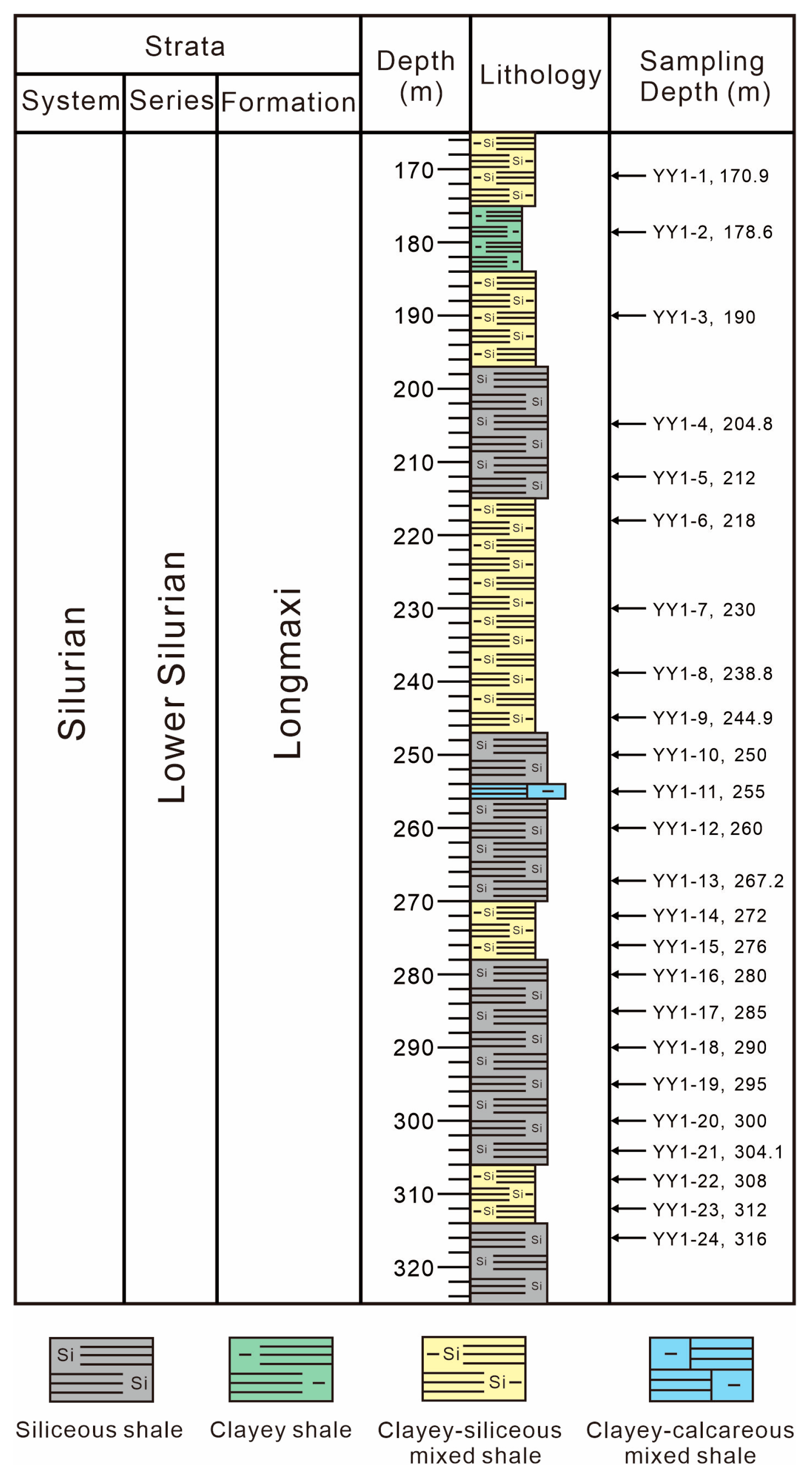
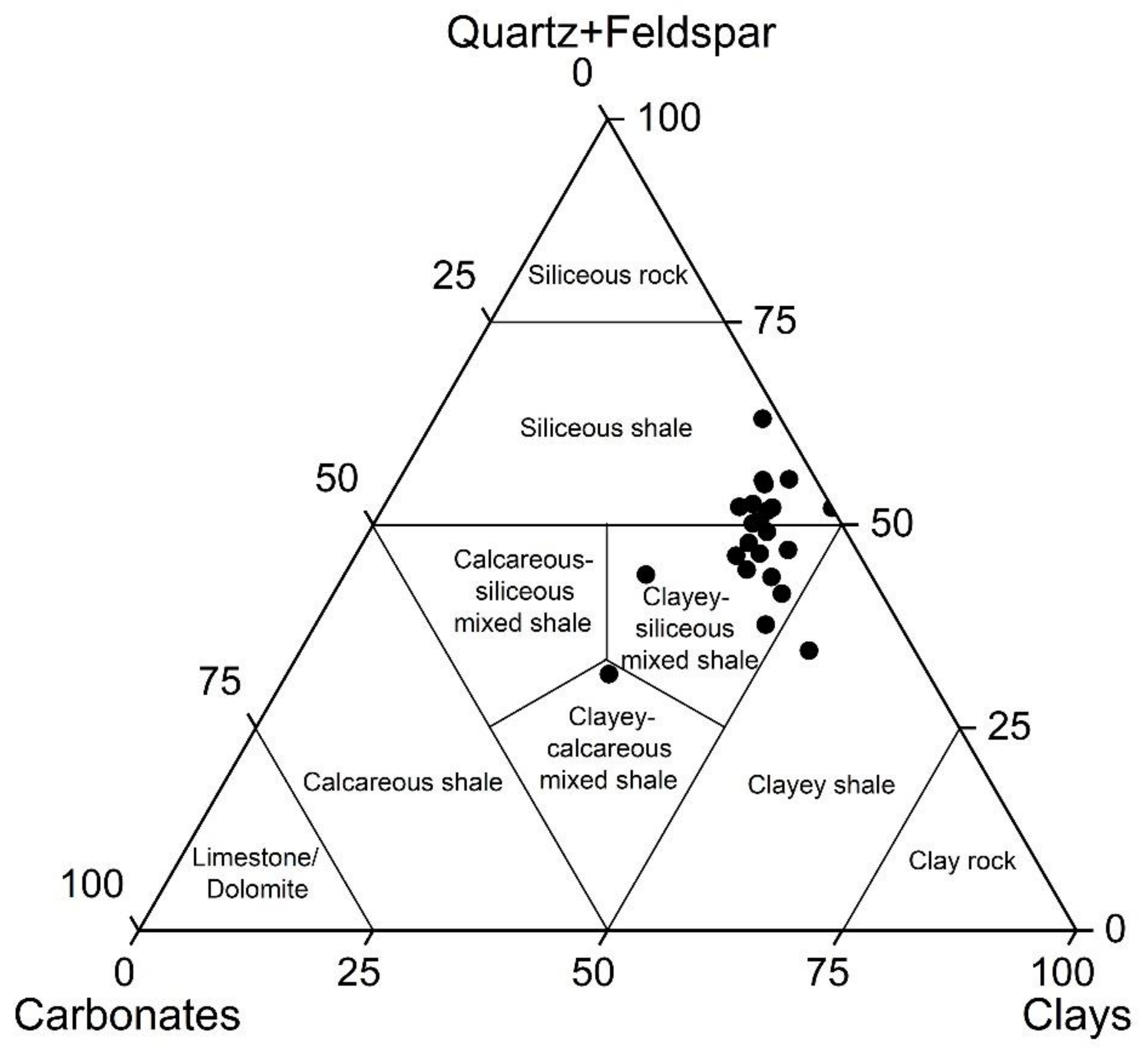
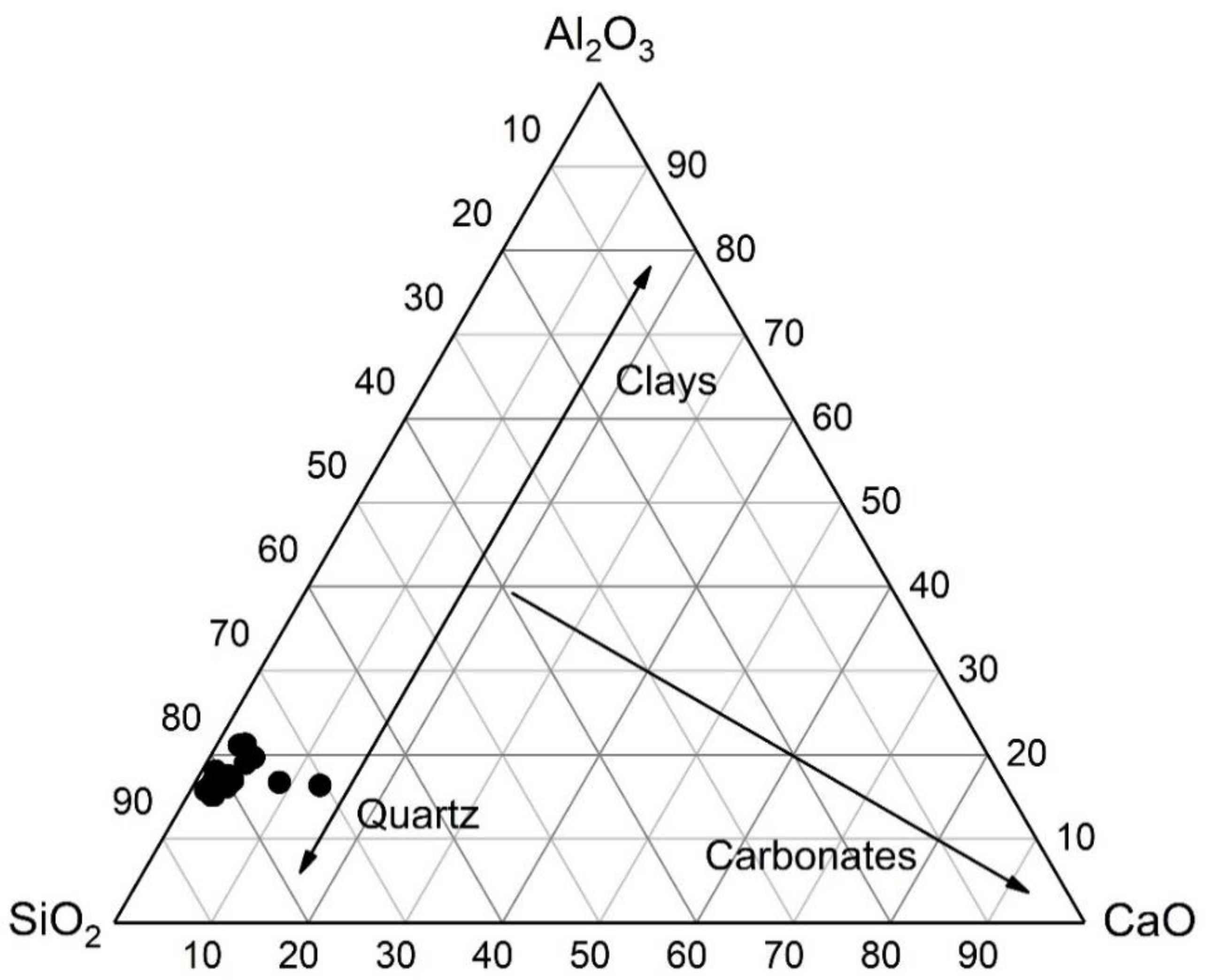
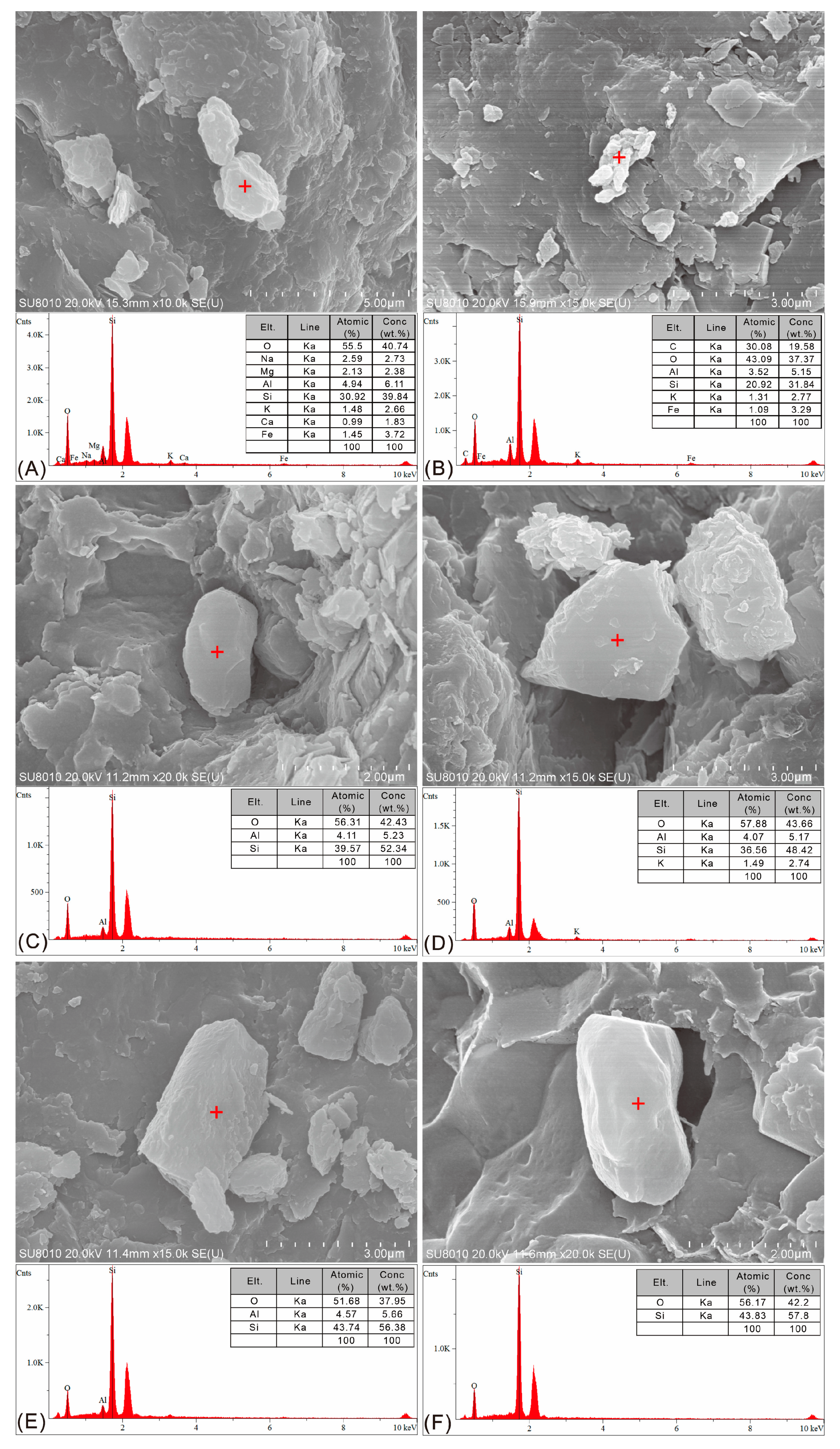

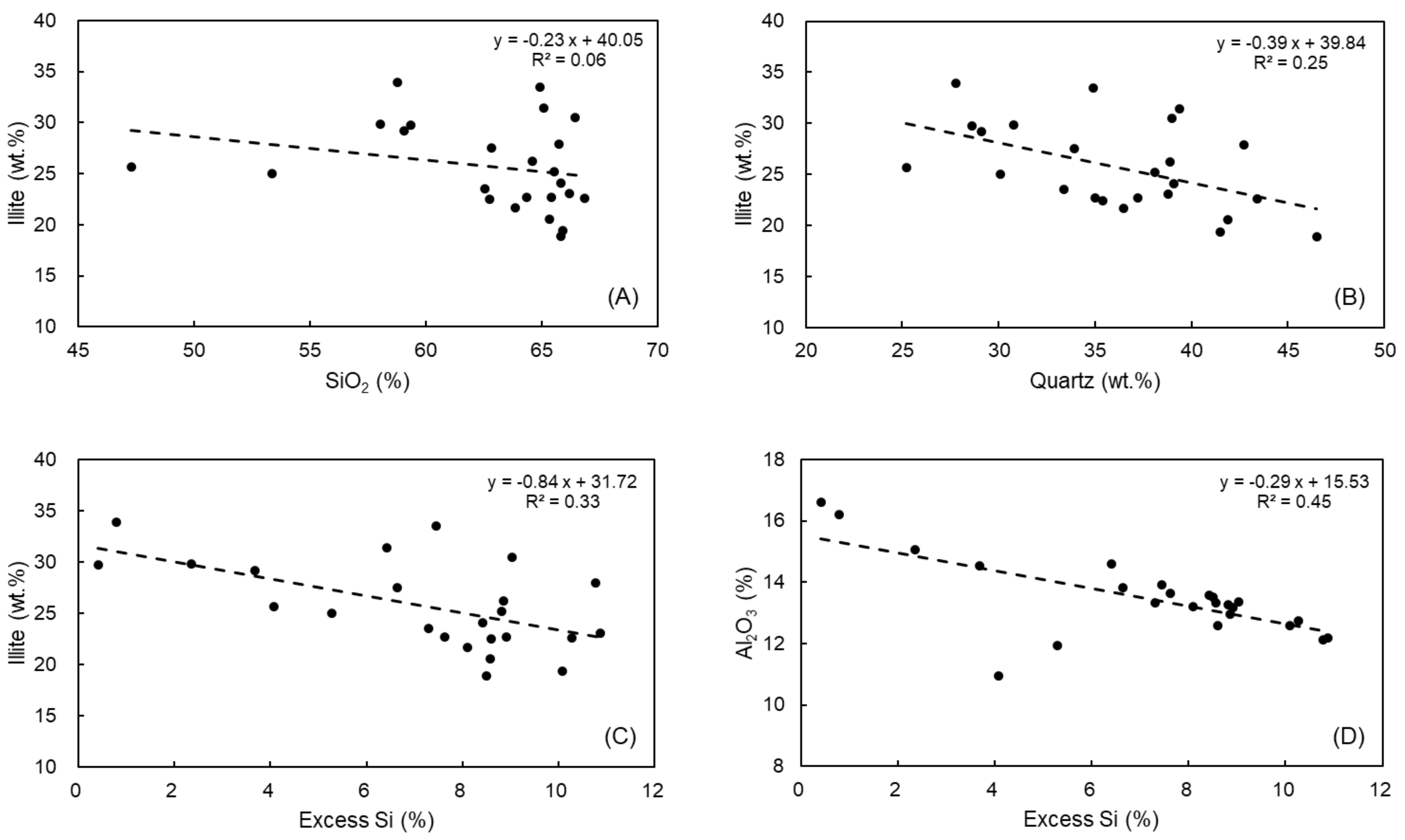
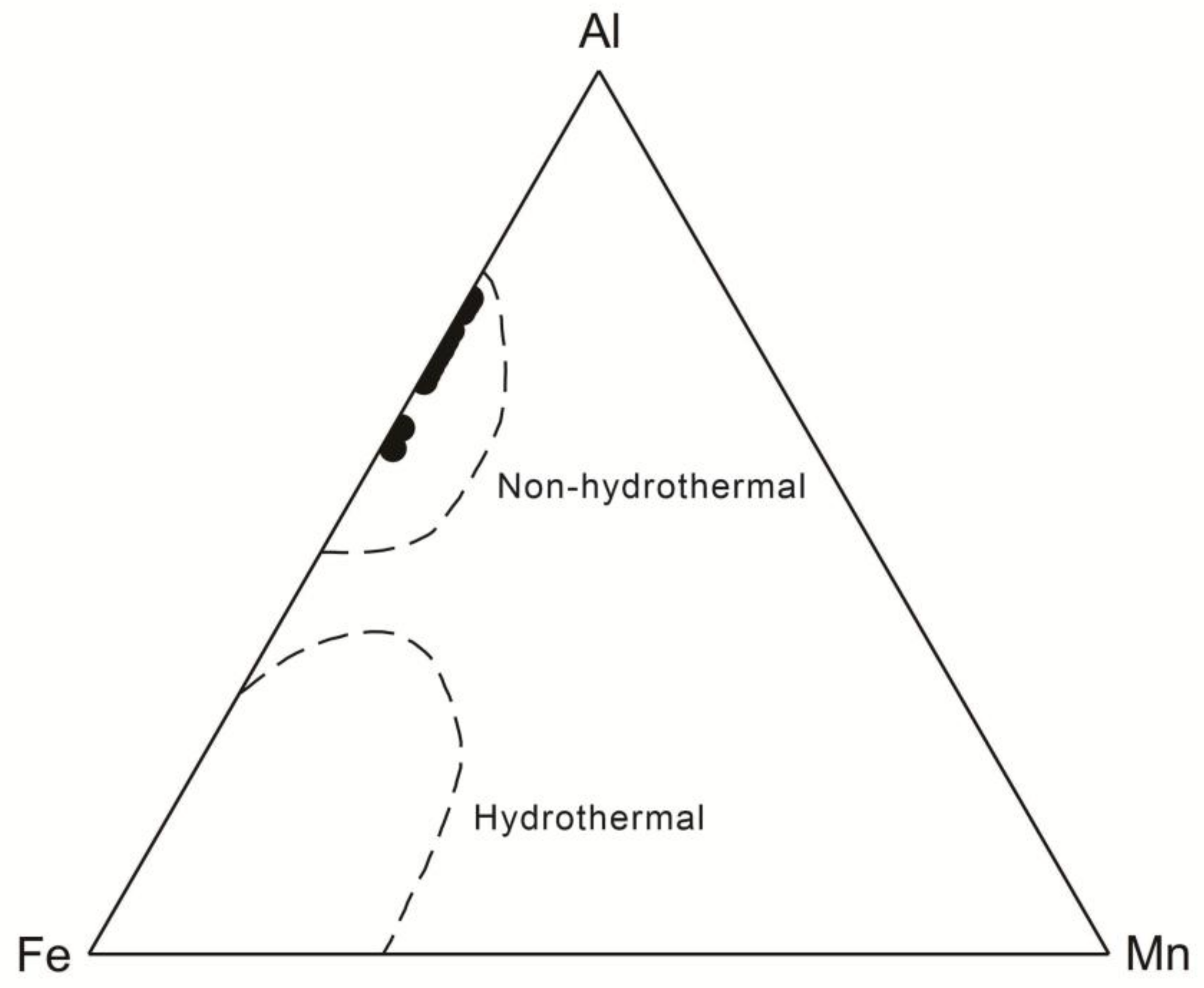

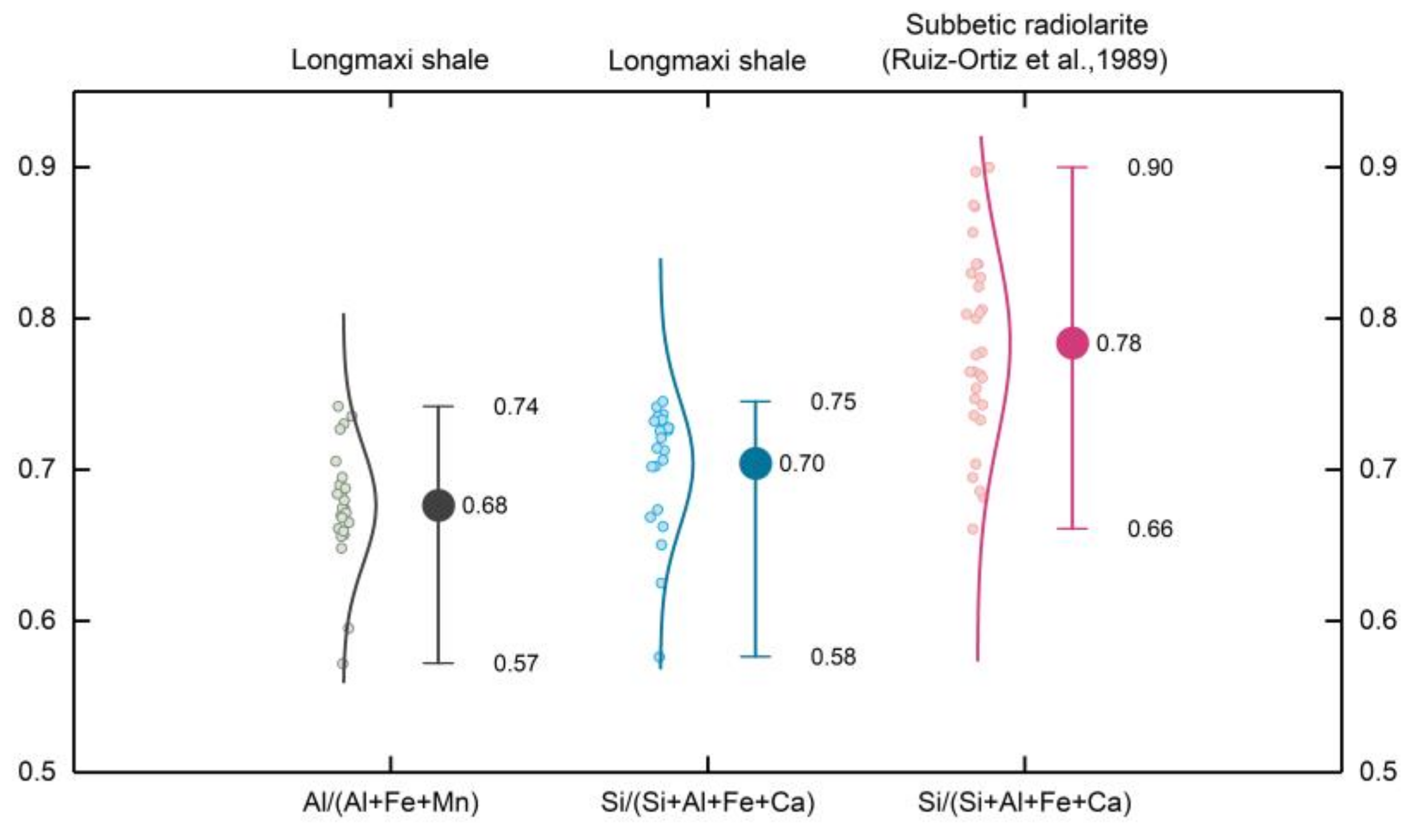

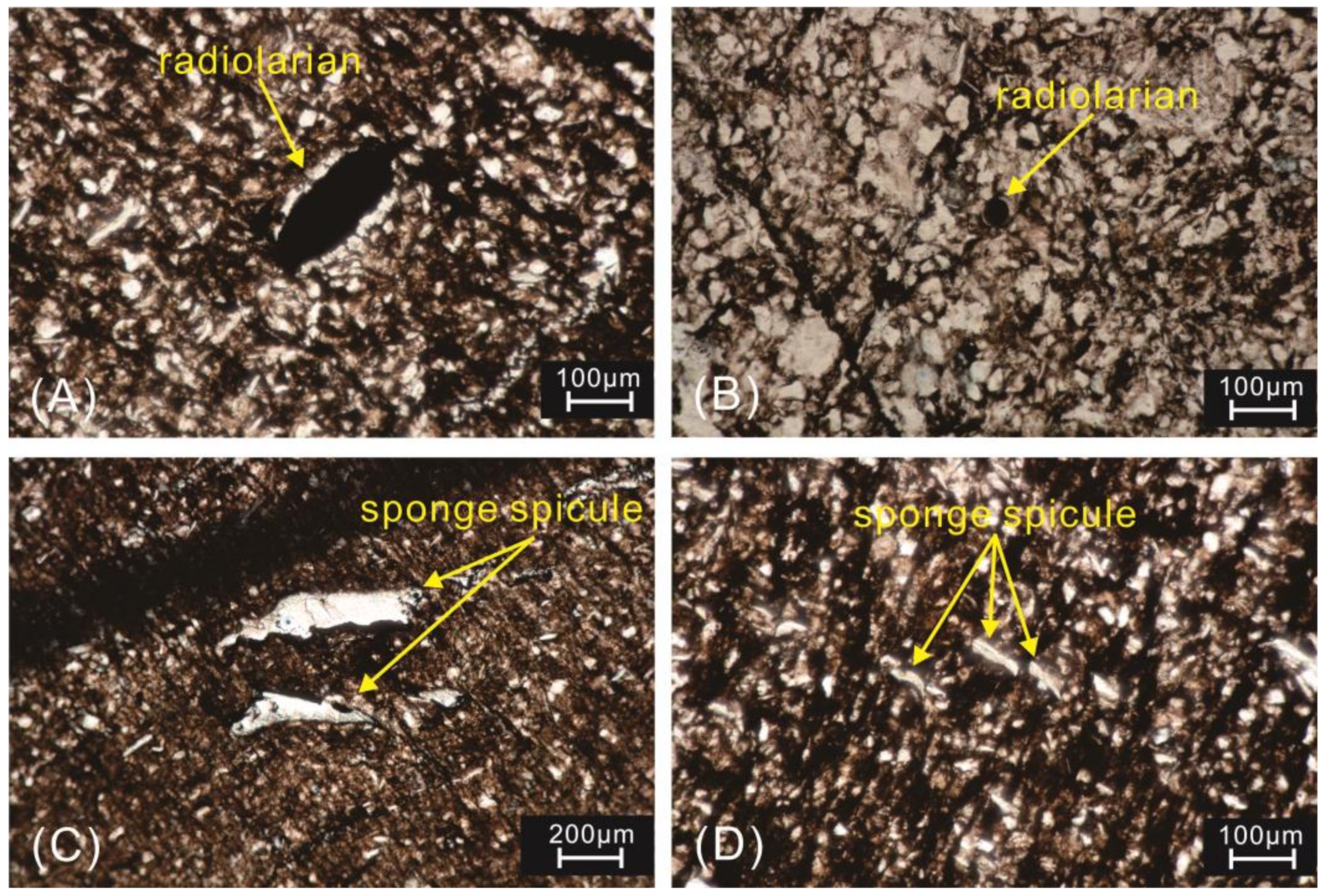

| Sample No. | Lithology | Depth (m) | TOC (%) | Whole Rock Minerals Composition (wt.%) | |||||||||
|---|---|---|---|---|---|---|---|---|---|---|---|---|---|
| Quartz | KF. | Plag. | Cal. | Dol. | Pyrite | I/S | Illite | Kao. | Chlo. | ||||
| YY1–1 | Clayey-Siliceous Mixed Shale | 170.9 | 1.05 | 30.8 | / | 6.4 | 5.1 | 9 | 1.3 | 13.3 | 29.9 | / | 4.3 |
| YY1–2 | Clayey shale | 178.6 | 1.34 | 27.8 | / | 5.9 | 4.2 | 6.8 | 2.3 | 14.8 | 33.9 | 1.1 | 3.2 |
| YY1–3 | Clayey-siliceous mixed shale | 190 | 1.89 | 29.1 | 0.7 | 11.1 | 3.8 | 6.7 | 1.5 | 14.1 | 29.2 | 0.9 | 2.8 |
| YY1–4 | Siliceous shale | 204.8 | 1.27 | 33.4 | 4.5 | 13.4 | 2.3 | 7.4 | 1.7 | 11.6 | 23.5 | 0.7 | 1.5 |
| YY1–5 | Siliceous shale | 212 | 1.35 | 38.1 | 1.7 | 11.2 | 2.8 | 4.2 | 1.4 | 12.6 | 25.2 | 0.8 | 2.0 |
| YY1–6 | Clayey-siliceous mixed shale | 218 | 1.53 | 33.9 | / | 13.1 | 4.1 | 6.8 | 1.6 | 10.1 | 27.5 | 0.8 | 2.0 |
| YY1–7 | Clayey-siliceous mixed shale | 230 | 1.09 | 28.6 | 2.6 | 11.8 | / | 10.6 | 1.3 | 14.0 | 29.8 | 0.5 | 0.9 |
| YY1–8 | Clayey-siliceous mixed shale | 238.8 | 1.6 | 35.4 | / | 10.2 | / | 13 | 1.3 | 15.2 | 22.5 | 0.8 | 1.6 |
| YY1–9 | Clayey-siliceous mixed shale | 244.9 | 2.08 | 36.5 | / | 6.9 | 6.6 | 6 | 2.4 | 16.6 | 21.6 | 0.8 | 2.5 |
| YY1–10 | Siliceous shale | 250 | 2.01 | 38.8 | 3.1 | 7.4 | 2.1 | 6.8 | 2 | 13.9 | 23.1 | 2.8 | / |
| YY1–11 | Clayey-calcareous mixed shale | 255 | 1.81 | 25.2 | / | 5.9 | 2.8 | 30.7 | 1.6 | 6.8 | 25.7 | 0.3 | 1.0 |
| YY1–12 | Siliceous shale | 260 | 2.57 | 42.7 | / | 6.3 | 3.7 | 4.6 | 2.8 | 10.0 | 27.9 | 0.4 | 1.6 |
| YY1–13 | Siliceous shale | 267.2 | 1.48 | 39.4 | 3.4 | 8.2 | / | / | 2.1 | 11.7 | 31.4 | / | 3.8 |
| YY1–14 | Clayey-siliceous mixed shale | 272 | 1.1 | 30.1 | 2.8 | 10.3 | / | 23.6 | 1.5 | 4.4 | 25.0 | / | 2.2 |
| YY1–15 | Clayey-siliceous mixed shale | 276 | 1.58 | 34.9 | 2.7 | 8.2 | / | 10.4 | 1.4 | 8.5 | 33.5 | 0.4 | / |
| YY1–16 | Siliceous shale | 280 | 1.54 | 39.1 | 3.9 | 11.6 | / | 5.6 | 1.6 | 11.8 | 24.1 | / | 2.3 |
| YY1–17 | Siliceous shale | 285 | 1.5 | 39 | 3.2 | 9.5 | 2.2 | 5.9 | 1.6 | 5.8 | 30.5 | 0.8 | 1.5 |
| YY1–18 | Siliceous shale | 290 | 1.38 | 41.9 | 3.8 | 9.3 | 2.8 | / | 1.1 | 17.3 | 20.6 | 1.2 | 2.1 |
| YY1–19 | Siliceous shale | 295 | 1.43 | 35 | 2.2 | 12.2 | 3.4 | 5.9 | 1.5 | 13.1 | 22.7 | 1.2 | 2.8 |
| YY1–20 | Siliceous shale | 300 | 1.56 | 46.5 | 2.7 | 12.8 | 1.9 | / | 1.7 | 12.7 | 18.9 | 0.7 | 2.1 |
| YY1–21 | Siliceous shale | 304.1 | 1.94 | 43.4 | 3 | 7.3 | / | 5.6 | 2.4 | 13.4 | 22.6 | 0.8 | 1.5 |
| YY1–22 | Clayey-siliceous mixed shale | 308 | 1.91 | 37.2 | 2.4 | 8.1 | 2.7 | 5.5 | 2.9 | 16.1 | 22.7 | 0.8 | 1.6 |
| YY1–23 | Clayey-siliceous mixed shale | 312 | 2.04 | 38.9 | / | 7.4 | 3.8 | 3.4 | 1.3 | 15.8 | 26.2 | / | 3.2 |
| YY1–24 | Siliceous shale | 316 | 2.21 | 41.5 | 2.7 | 6.5 | / | 6.2 | 2.7 | 18.2 | 19.4 | / | 2.8 |
| Sample NO. | Major Oxides (%) | Excess Si (%) | SiO2/Al2O3 | Si/(Si + Al + Fe + Ca) | Al/(Al + Fe + Mn) | |||||||||||
|---|---|---|---|---|---|---|---|---|---|---|---|---|---|---|---|---|
| SiO2 | Al2O3 | TFe2O3 | MgO | CaO | Na2O | K2O | MnO | TiO2 | P2O5 | LOI | Total | |||||
| YY1–1 | 58.02 | 15.05 | 5.88 | 3.03 | 3.48 | 1.1 | 4.01 | 0.054 | 0.724 | 0.12 | 7.99 | 99.458 | 2.35 | 3.86 | 0.65 | 0.66 |
| YY1–2 | 58.78 | 16.21 | 5.89 | 2.76 | 1.81 | 1.03 | 4.38 | 0.036 | 0.761 | 0.112 | 7.77 | 99.539 | 0.79 | 3.63 | 0.66 | 0.67 |
| YY1–3 | 59.05 | 14.53 | 5.38 | 2.43 | 3.1 | 1.41 | 3.78 | 0.035 | 0.726 | 0.118 | 8.99 | 99.549 | 3.69 | 4.06 | 0.67 | 0.67 |
| YY1–4 | 62.56 | 13.33 | 4.6 | 2.36 | 2.97 | 1.61 | 3.4 | 0.042 | 0.711 | 0.123 | 7.81 | 99.516 | 7.30 | 4.69 | 0.70 | 0.68 |
| YY1–5 | 65.54 | 13.26 | 4.47 | 2.14 | 1.98 | 1.54 | 3.39 | 0.033 | 0.69 | 0.117 | 6.42 | 99.58 | 8.81 | 4.94 | 0.73 | 0.69 |
| YY1–6 | 62.83 | 13.81 | 4.99 | 2.3 | 2.32 | 1.63 | 3.45 | 0.039 | 0.739 | 0.114 | 7.36 | 99.582 | 6.64 | 4.55 | 0.70 | 0.67 |
| YY1–7 | 59.33 | 16.6 | 4.32 | 2.68 | 2.27 | 1.44 | 4.63 | 0.043 | 0.764 | 0.111 | 7.25 | 99.438 | 0.41 | 3.57 | 0.67 | 0.74 |
| YY1–8 | 62.75 | 12.59 | 5.1 | 2.56 | 2.73 | 1.19 | 3.42 | 0.061 | 0.658 | 0.111 | 8.4 | 99.57 | 8.61 | 4.98 | 0.71 | 0.65 |
| YY1–9 | 63.87 | 13.22 | 5.09 | 2.08 | 2.05 | 1.2 | 3.49 | 0.031 | 0.683 | 0.114 | 7.72 | 99.548 | 8.10 | 4.83 | 0.71 | 0.66 |
| YY1–10 | 66.2 | 12.19 | 4.6 | 1.99 | 1.95 | 1.04 | 3.3 | 0.037 | 0.626 | 0.106 | 7.48 | 99.519 | 10.88 | 5.43 | 0.74 | 0.67 |
| YY1–11 | 47.29 | 10.95 | 6.02 | 5 | 8.72 | 0.734 | 3.23 | 0.157 | 0.523 | 0.104 | 16.79 | 99.518 | 4.08 | 4.32 | 0.58 | 0.57 |
| YY1–12 | 65.73 | 12.12 | 4.45 | 1.75 | 2.15 | 1.07 | 3.39 | 0.028 | 0.647 | 0.116 | 8 | 99.451 | 10.78 | 5.42 | 0.74 | 0.67 |
| YY1–13 | 65.1 | 14.59 | 4.04 | 1.91 | 1.16 | 1.38 | 4.59 | 0.031 | 0.789 | 0.143 | 5.81 | 99.543 | 6.42 | 4.46 | 0.73 | 0.73 |
| YY1–14 | 53.38 | 11.95 | 6.01 | 4.07 | 6.2 | 1.38 | 3.21 | 0.121 | 0.646 | 0.121 | 12.36 | 99.448 | 5.28 | 4.47 | 0.63 | 0.60 |
| YY1–15 | 64.91 | 13.91 | 3.92 | 1.5 | 1.63 | 1.57 | 4.42 | 0.031 | 0.747 | 0.133 | 6.74 | 99.511 | 7.45 | 4.67 | 0.73 | 0.73 |
| YY1–16 | 65.81 | 13.57 | 4.25 | 1.89 | 1.47 | 1.42 | 4.09 | 0.029 | 0.718 | 0.123 | 6.24 | 99.61 | 8.43 | 4.85 | 0.73 | 0.71 |
| YY1–17 | 66.42 | 13.37 | 3.6 | 1.82 | 1.71 | 1.47 | 3.89 | 0.032 | 0.717 | 0.128 | 6.42 | 99.577 | 9.04 | 4.97 | 0.74 | 0.74 |
| YY1–18 | 65.31 | 13.34 | 4.71 | 2.13 | 1.77 | 1.48 | 3.47 | 0.036 | 0.707 | 0.122 | 6.44 | 99.515 | 8.57 | 4.90 | 0.72 | 0.68 |
| YY1–19 | 64.34 | 13.64 | 4.73 | 2.18 | 2.09 | 1.65 | 3.5 | 0.031 | 0.743 | 0.136 | 6.58 | 99.62 | 7.62 | 4.72 | 0.71 | 0.68 |
| YY1–20 | 65.81 | 13.52 | 4.45 | 1.96 | 1.74 | 1.69 | 3.48 | 0.031 | 0.724 | 0.132 | 6.02 | 99.557 | 8.51 | 4.87 | 0.73 | 0.70 |
| YY1–21 | 66.84 | 12.74 | 4.34 | 1.84 | 1.26 | 1.26 | 3.49 | 0.029 | 0.674 | 0.113 | 6.83 | 99.416 | 10.27 | 5.25 | 0.75 | 0.69 |
| YY1–22 | 65.4 | 13.16 | 4.9 | 1.9 | 1.62 | 1.39 | 3.7 | 0.034 | 0.699 | 0.124 | 6.56 | 99.487 | 8.91 | 4.97 | 0.73 | 0.67 |
| YY1–23 | 64.57 | 12.96 | 5.1 | 2.02 | 1.74 | 1.17 | 3.47 | 0.033 | 0.676 | 0.107 | 7.74 | 99.586 | 8.85 | 4.98 | 0.72 | 0.66 |
| YY1–24 | 65.9 | 12.59 | 4.88 | 1.96 | 1.66 | 1.14 | 3.38 | 0.034 | 0.658 | 0.124 | 7.19 | 99.516 | 10.08 | 5.23 | 0.73 | 0.66 |
Publisher’s Note: MDPI stays neutral with regard to jurisdictional claims in published maps and institutional affiliations. |
© 2020 by the authors. Licensee MDPI, Basel, Switzerland. This article is an open access article distributed under the terms and conditions of the Creative Commons Attribution (CC BY) license (http://creativecommons.org/licenses/by/4.0/).
Share and Cite
Liang, Y.; Zhang, J.; Liu, Y.; Tang, X.; Li, Z.; Ding, J.; Wang, Y.; Yang, S. Evidence for Biogenic Silica Occurrence in the Lower Silurian Longmaxi Shale in Southeastern Chongqing, China. Minerals 2020, 10, 945. https://doi.org/10.3390/min10110945
Liang Y, Zhang J, Liu Y, Tang X, Li Z, Ding J, Wang Y, Yang S. Evidence for Biogenic Silica Occurrence in the Lower Silurian Longmaxi Shale in Southeastern Chongqing, China. Minerals. 2020; 10(11):945. https://doi.org/10.3390/min10110945
Chicago/Turabian StyleLiang, Yutao, Jinchuan Zhang, Yang Liu, Xuan Tang, Zhen Li, Jianghui Ding, Yang Wang, and Sen Yang. 2020. "Evidence for Biogenic Silica Occurrence in the Lower Silurian Longmaxi Shale in Southeastern Chongqing, China" Minerals 10, no. 11: 945. https://doi.org/10.3390/min10110945
APA StyleLiang, Y., Zhang, J., Liu, Y., Tang, X., Li, Z., Ding, J., Wang, Y., & Yang, S. (2020). Evidence for Biogenic Silica Occurrence in the Lower Silurian Longmaxi Shale in Southeastern Chongqing, China. Minerals, 10(11), 945. https://doi.org/10.3390/min10110945





